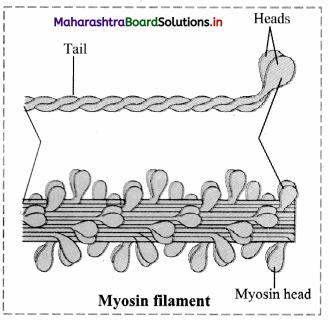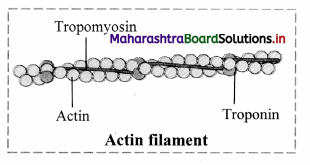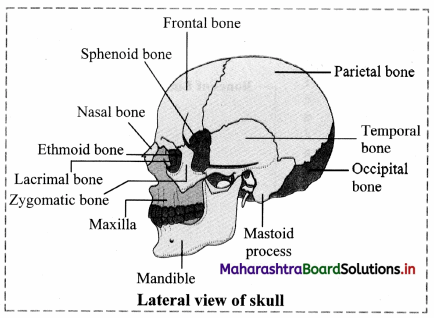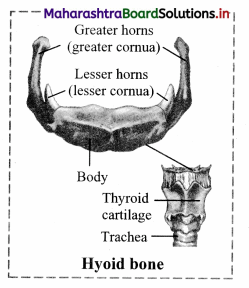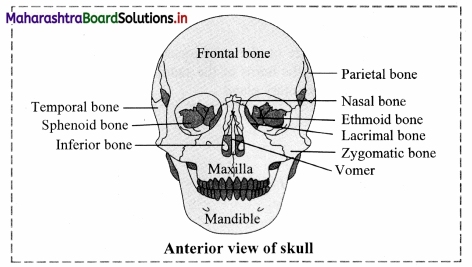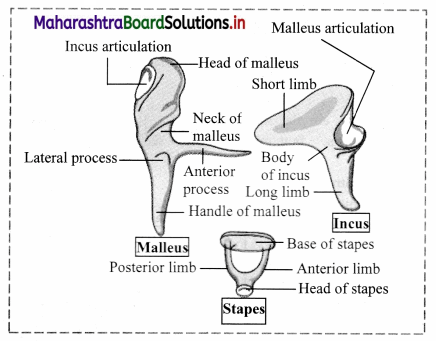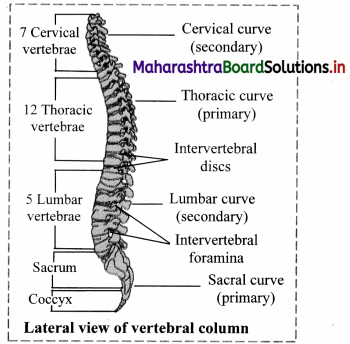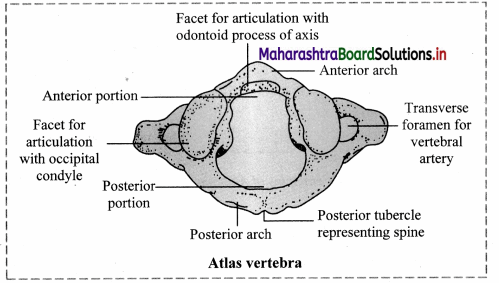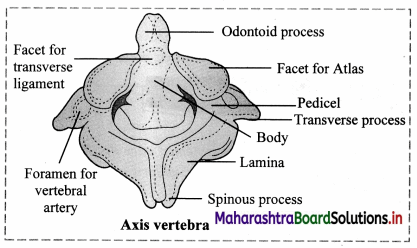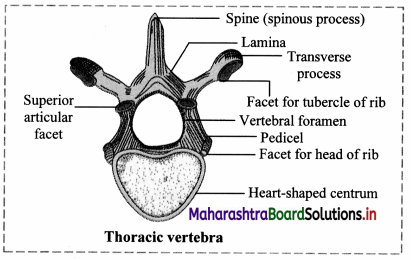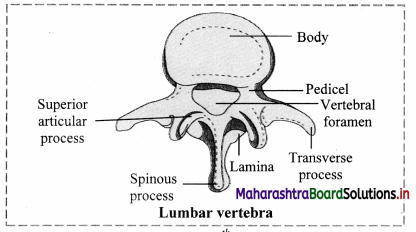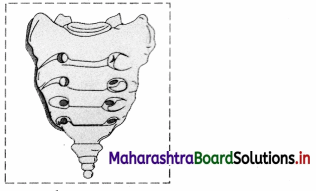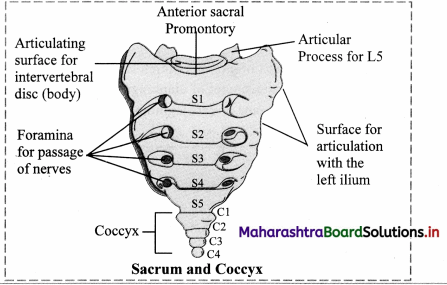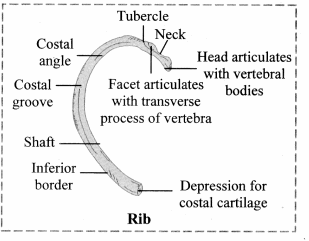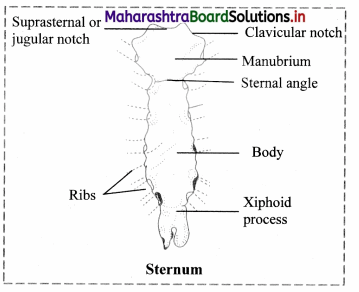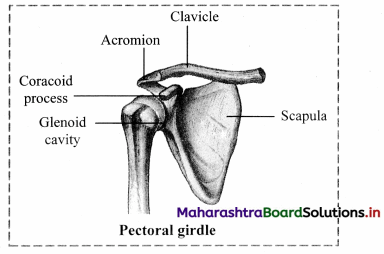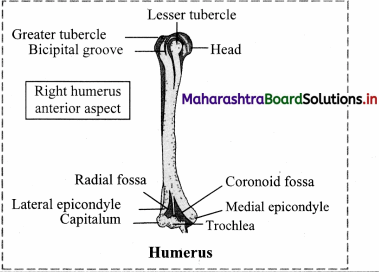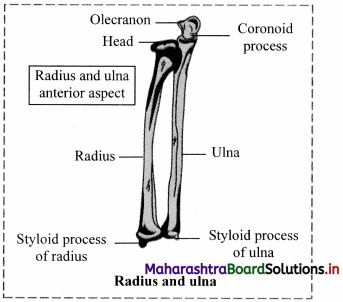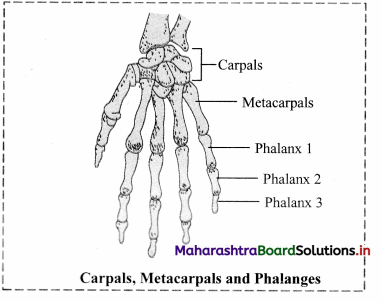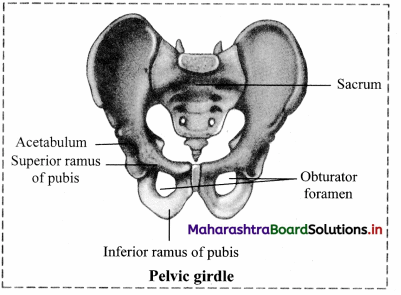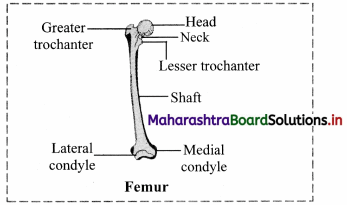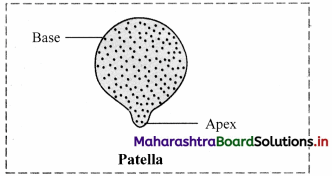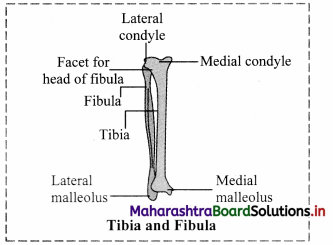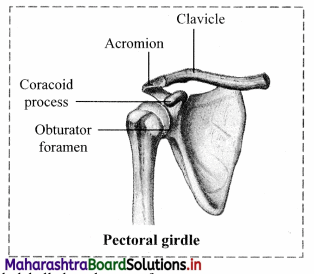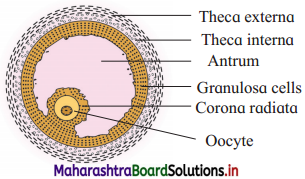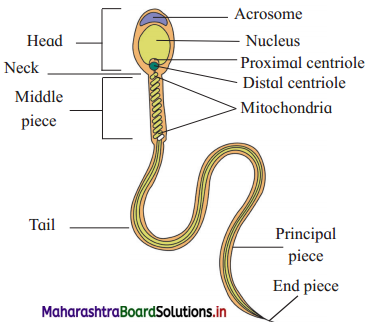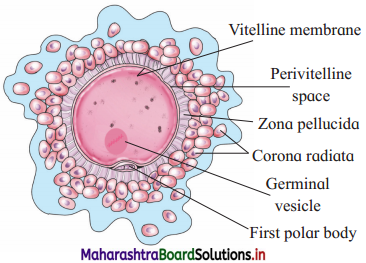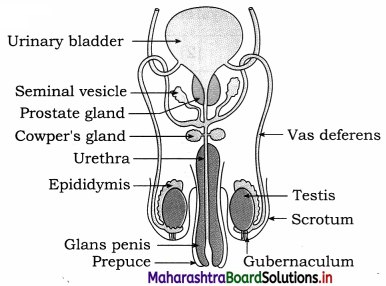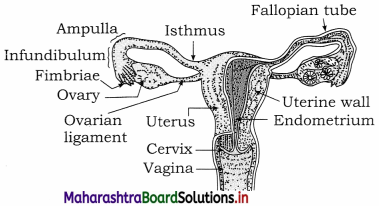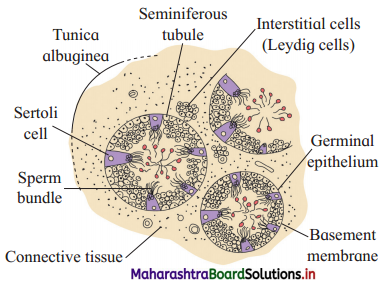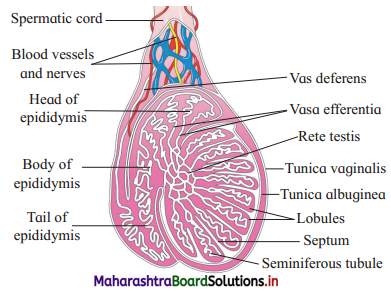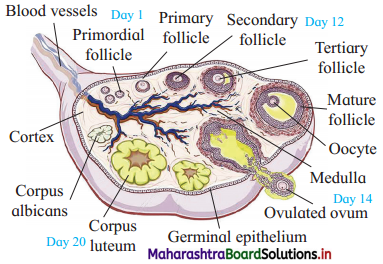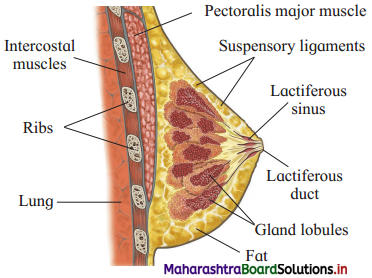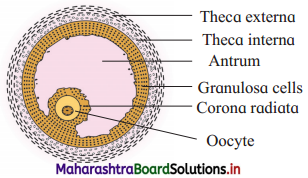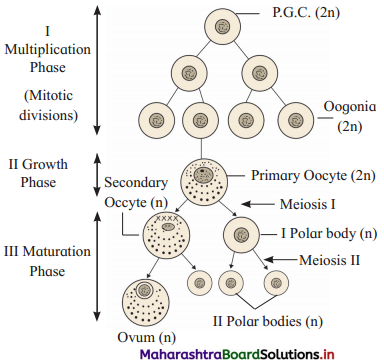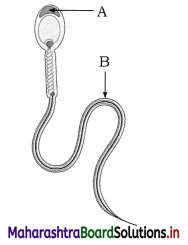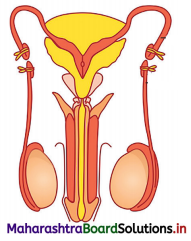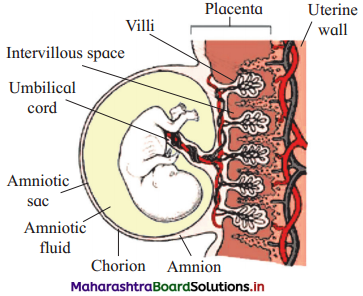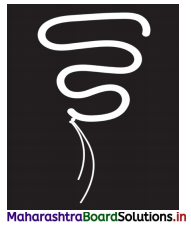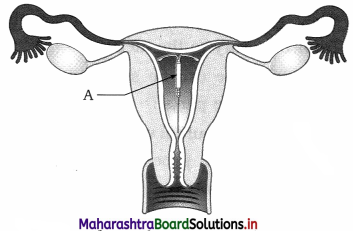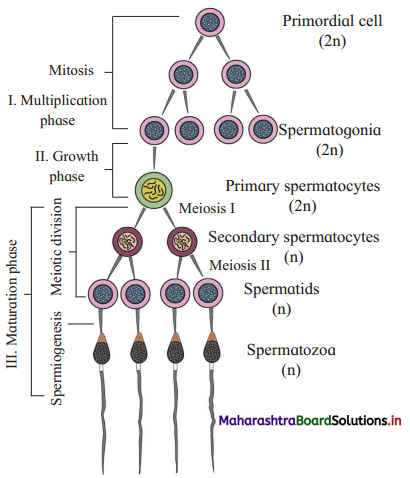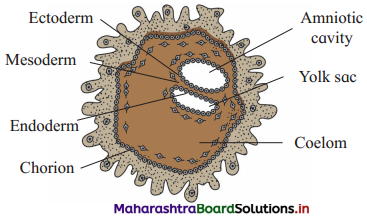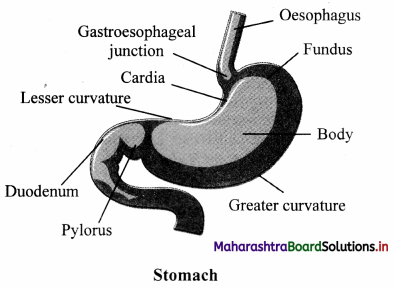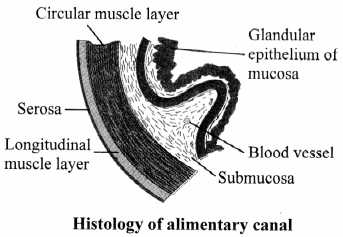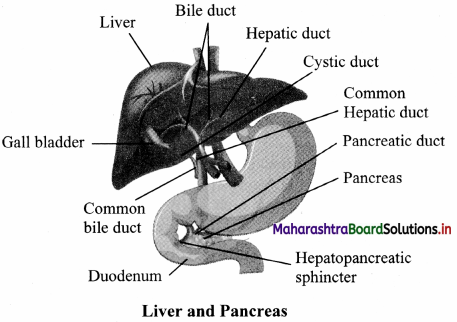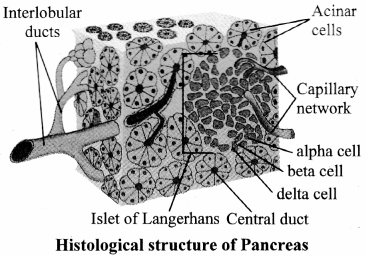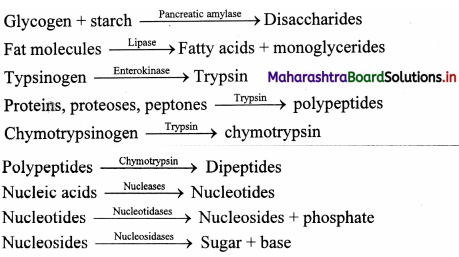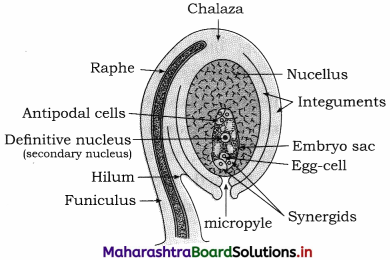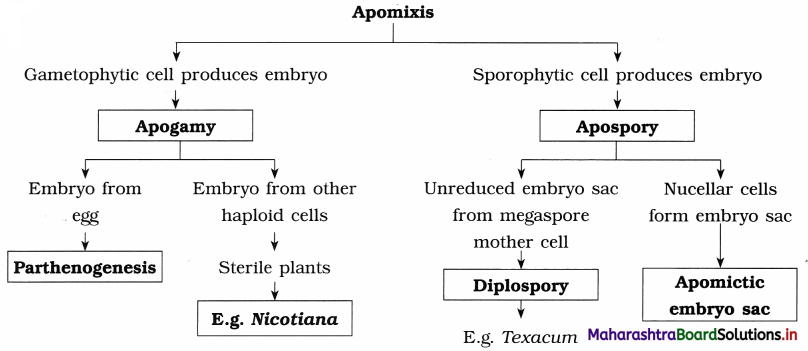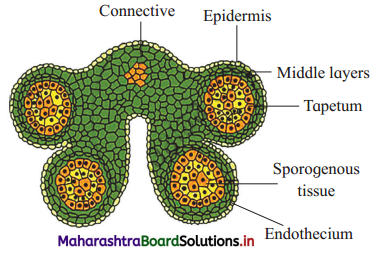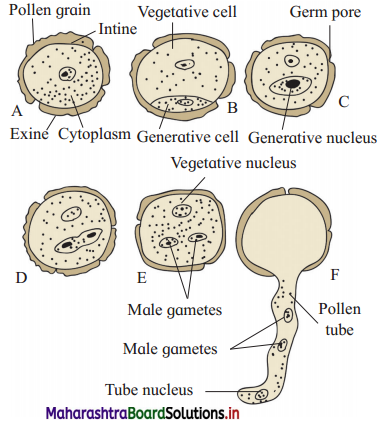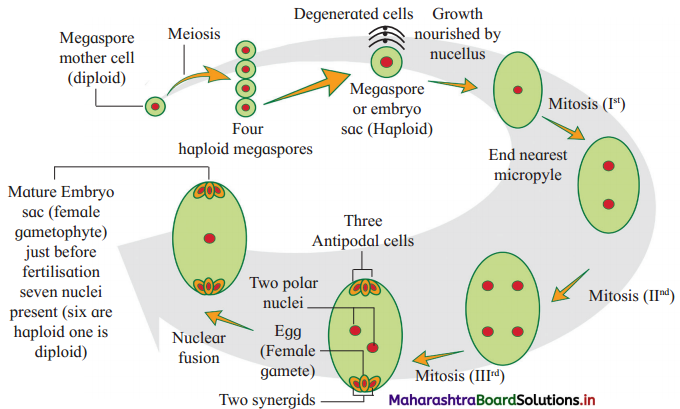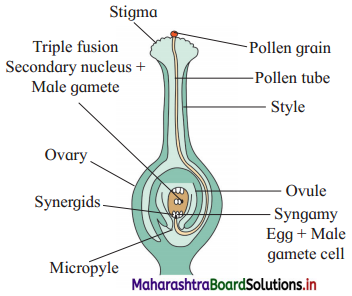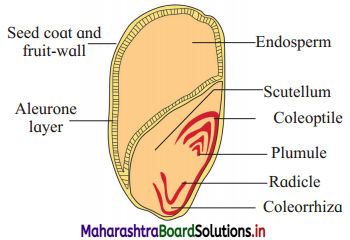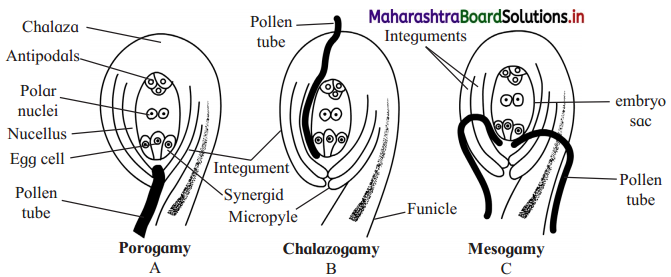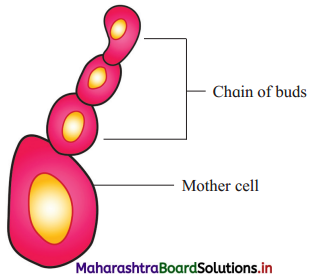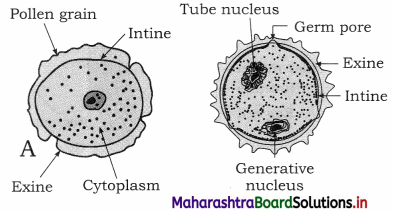Balbharti Maharashtra State Board 11th Biology Important Questions Chapter 15 Excretion and Osmoregulation Important Questions and Answers.
Maharashtra State Board 11th Biology Important Questions Chapter 15 Excretion and Osmoregulation
Question 1.
What are metabolic waste products?
Answer:
Metabolism produces a variety of by-products, some of which need to be eliminated. Such by-products are called metabolic waste products.
Question 2.
Define excretion.
Answer:
The process of eliminating waste products from the body is called excretion.
![]()
Question 3.
Where are metabolic wastes produced?
Answer:
Metabolic wastes are produced inside body cells.
Question 4.
Enlist the various excretory products produced in the human body.
Answer:
The various excretory products produced by the human body are as follows:
- Fluids such as water; gaseous wastes like CO2; nitrogenous wastes like ammonia, urea and uric acid, creatinine; minerals; salts of sodium, potassium, calcium, etc. if present in body in excess are excreted through urine, faeces and sweat.
- Pigments formed due to breakdown of haemoglobin like bilirubin (excreted through faeces) and urochrome (eliminated through urine).
- The pigments present in consumed foodstuffs like beet root or excess of vitamins, hormones and drugs.
- Volatile substances present in spices (eliminated through lungs).
Question 5.
Write a note on deamination.
Answer:
- Deamination is the process of breakdown of excess amino acids.
- It is an essential process, since the body of an organism is unable to store excess amino acids.
- In this process, amino group is separated from the amino acid and ammonia is formed.
- Toxic ammonia is either excreted or converted to less toxic forms like urea or uric acid before excretion.
![]()
Question 6.
Availability of water plays a key role in deciding the mode of excretion of an organism. Justify.
Answer:
- Ammonia is the basic product of deamination process.
- Ammonia is highly toxic and needs to be diluted immediately.
- If there is no or limited access to water, need for conversion of ammonia becomes necessary.
Hence, the availability of water plays a key role in deciding the mode of excretion of an organism.
Question 7.
What are the three main modes of excretion in animals?
Answer:
The three main modes of excretion in animals are as follows:
i. Ammonotelism
ii. Ureotelism
iii. Uricotelism
- Ammonotelism:
- Elimination of nitrogenous wastes in the form of ammonia is called as ammonotelism.
- Ammonia is basic in nature and hence it can disturb the pH of the body, if not eliminated immediately.
- Any change in pH would disturb all enzyme catalyzed reactions in the body and would also make the plasma membrane unstable.
- Ammonia is readily soluble in water and needs large quantity of water to dilute and reduce its toxicity.
- This is however an energy saving mechanism of excretion and hence all animals that have plenty of water available for dilution of ammonia, excrete nitrogenous wastes in the form of ammonia.
- Animals that follow this mode of excretion are known as ammonotelic animals.
- 1 gm ammonia needs about 300 – 500 ml of water for elimination.
- Ammonotelic animals excrete ammonia through general body surface (skin), gills and kidneys.
e.g. Ammonotelism is found in aquatic invertebrates, bony fishes, and aquatic / larval amphibians. Animals without excretory system (Protozoa) are also ammonotelic.
- Ureotelism:
- Elimination of nitrogenous wastes in the form of urea is called as ureotelism.
- Urea is comparatively less toxic and less water-soluble than ammonia. Hence, it can be concentrated to some extent in body.
- The body requires less water for elimination.
- Since it is less toxic and less water soluble, ureotelism is suitable for animals that need to conserve water to some extent. Hence, ureotelism is common in terrestrial animals, as they have to conserve water.
- It takes about 50 ml H2O for removal of 1 gm NH2 in form of urea.
- Ureotelic animals generally convert ammonia to urea in the liver by operating ornithine / urea cycle in which 3 ATP molecules are used to produce one molecule of urea.
e.g. Mammals, cartilaginous fishes (sharks and rays), many aquatic reptiles, most of the adult amphibians, etc. are ureotelic.
- Uricotelism:
- Elimination of nitrogenous wastes in the form of uric acid is called as uricotelism.
- Uric acid is least toxic and hence, it can be retained in the body for some time in concentrated form.
- It is least soluble in water. Hence there is minimum (about 5 – 10 ml for 1 gm) or no need of water for its elimination.
- Those animals which need to conserve more water follow uricotelism. However, these animals need to spend more energy.
- Ammonia is converted into uric acid by ‘inosinic acid pathway’ in the liver of birds, e.g. Birds, some insects, many reptiles, land snails, are uricotelic.
Question 8.
Fill in the blanks:
i. ________ is the basic product of deamination process.
ii. Aquatic amphibians excrete nitrogenous waste in the form of _______.
iii. Uricotelic organisms, convert ammonia to urea in the _______ by operating _____ cycle.
iv. Ammonia is converted into uric acid by ______ pathway in birds.
Answer:
i. Ammonia
ii. Ammonia
iii. liver, omithine/urea
iv. inosinic acid
Question 9.
Explain the following sentences,
i. Humans are ureotelic.
Answer:
- Urea is comparatively less toxic and less water – soluble than ammonia. Hence, it can be concentrated to some extent in the body.
- The body requires less water for elimination of urea.
c. Due to these properties, ureotelism is suitable for animals which need to conserve water to some extent.
Thus, humans are ureotelic.
ii. Sharks retain more urea in their blood.
Answer:
- Sharks retain more urea in their body fluid (blood) to make their blood isotonic to surrounding marine water (in order to maintain osmotic balance).
- This helps them to prevent possible loss of water by exosmosis.
Question 10.
Distinguish between Ureotelism and Uricotelism.
Answer:
| No. | Ureotelism | Uricotelism |
| i. | It is the elimination of nitrogenous waste in the form of urea. | It is the elimination of nitrogenous waste in the form of uric acid. |
| ii. | Excretion of urea requires less (moderate ) amount of water. | Excretion of uric acid requires negligible amount of water. |
| iii. | Removal of 1 gm of urea requires 50 ml of water. | Removal of 1 gm of uric acid requires 5 – 10 ml of water, j |
| iv. | Urea is less toxic. | Uric acid is least toxic. |
| e.g. | It is generally seen in terrestrial animals. Mammals, cartilaginous fishes (sharks and rays), many aquatic reptiles, most adult amphibians, etc. | It is seen in birds, some insects, many reptiles, land snails, etc. |
![]()
Question 11.
Distinguish between Ammonotelism and Uricotelism.
Answer:
|
No. |
Ammonotelism |
Uricotelism |
| i. | It is the elimination of nitrogenous waste in the form of ammonia. | It is the elimination of nitrogenous waste in the form of uric acid. |
| ii. | Excretion of ammonia requires plenty of water. | Excretion of uric acid requires negligible amount of water. |
| iii. | Removal of 1 gm of ammonia requires 300 – 500 ml of water. | Removal of 1 gm of uric acid requires 10ml of water. |
| iv. | Ammonia is very toxic. | Uric acid is less toxic. |
| e.g. | It is found in aquatic invertebrates, bony fishes and aquatic/ larval amphibians, etc. | It is seen in birds, some insects, many reptiles, land snails, etc. |
Question 12.
Terrestrial animals are generally either ureotelic or uricotelic, not ammonotelic. Why?
Answer:
- Ammonia is highly toxic to animals.
- An animal requires large amount of water to dissolve and eliminate ammonia.
- Terrestrial animals cannot lose such a large amount of water.
- Ureotelic and uricotelic animals require less amount of water for removal of nitrogenous waste. Hence, to conserve water, ureotelism and uricotelism is adapted by terrestrial animals.
Question 13.
What is plasma creatinine? Why is it used as an index of kidney function?
Answer:
- Plasma creatinine is produced from catabolism of creatinine phosphate during skeletal muscle contraction.
- It provides a ready source of high energy phosphate.
- Normally blood creatinine levels remain steady because the rate of production matches its excretion in urine.
- Hence, plasma creatinine is used as an index of kidney function and its level above normal is an indication of poor renal function.
[Note: Plasma creatinine is a waste product produced by muscles from the breakdown of a compound called ‘creatine phosphate.]
Question 14.
How can excretion play a role in homeostasis?
Answer:
- Homeostasis is the maintenance of constant internal environment of the body.
- Homeostasis is however dependent on osmoregulation, which is the process of controlling solute concentrations and water balance.
- The composition of blood and therefore the internal environment is highly dependent on what the excretory organs retain in the body.
Hence, excretion plays an important role in homeostasis.
Question 15.
How do different organisms carry out excretion?
Answer:
Different organisms carry out excretion in the following manner:
- Unicellular organisms have contractile vacuoles which collect and discharge waste products outside the cell.
- Excretion in sponges takes place by diffusion of waste material in water. This waste is discharged through the osculum.
- True organs of excretion are found in those animals that show bilateral symmetry.
- The most common type of excretory organ is a simple or branching tube that opens to the exterior, through pores called nephridiopores. This system is generally found in some annelids, Amphioxus, earthworms, etc.
- In most of the insects, excretion takes place by a set of blind ended tubules called malpighian tubules.
- Crustaceans have green glands as excretory organs.
- Members of phylum Echinodermata do not have any specialised excretory organs. Waste materials directly diffuse into water or are excreted through tube feet.
- The mammalian kidneys are a collection of functional units called nephrons, which are well designed to excrete metabolic waste.
![]()
Question 16.
What are nephridia? Explain the major types of nephridia in detail.
Answer:
Nephridia are simple or branching tubules used for excretion which open to the exterior through pores called nephridiopores.
Two major types of nephridia are as follows:
i. Protonephridia:
These are network of dead end tubes called flame cells. They are mostly found in animals that lack a true body cavity, e.g. Platyhelminthes, rotifers, some annelids and Amphioxus.
ii. Metanephridia:
These are unbranched coiled tubes that are connected to the body cavity through funnel like structures called nephrostomes. Body fluid enters the nephridium through nephrostome and gets discharged ‘ through nephridiopore. e.g. Earthworms.
Question 17.
Distinguish between the Ureter and Urethra.
Answer:
| No. | Ureter | Urethra |
| i. | Ureters are two duct-like structures arising from the hilum of the kidney. | Urethra is a single tube-like structure arising from the urinary bladder. |
| ii. | Ureter carries urine from the kidney to the urinary bladder. | Urethra carries urine from the urinary bladder to the exterior of the body. |
| iii. | Ureters are paired structures. | Urethra is unpaired structure. |
Question 18.
Write a short note on micturition.
Answer:
- The process of release of urine from the urinary bladder is called micturition.
- The average capacity of urinary bladder is 700 ml.
- When urinary bladder is almost half filled, stretch receptors in urinary bladder transmit impulses to spinal cord, initiating a conscious desire to expel urine.
- Micturition reflex center of spinal cord transmit impulses to the wall of urinary bladder and internal urethral sphincter.
- Bladder muscles contract and muscles of internal urethral sphincter relax.
- The external sphincter receives impulses from conscious centre of brain and relaxes.
- This leads to elimination of urine from the bladder.
Question 19.
Explain the L.S of kidney with a neat and labelled diagram.
Answer:
- Each kidney is covered by three layers of tissue, namely the outermost renal fascia, middle adipose capsule and innermost renal capsule.
- The outermost layer, renal fascia is made up of a thin layer of fibrous connective tissue. It anchors the kidney to the abdominal wall as well as surrounding tissue.
- The middle layer is a mass of fatty tissue called adipose capsule. It protects the kidneys by shock absorption.
- The innermost layer, renal capsule is a smooth transparent fibrous membrane that is continuous with outer layer of ureters. It acts as a barrier against spread of infections in kidney.
- The L.S. of kidney shows two distinct regions within the capsule. Histologically, kidney is divisible into two regions as renal cortex and renal medulla.
- Renal cortex is the outer / peripheral, red coloured and granular region. It contains Malpighian bodies, convoluted tubules and blood vessels.
- Medulla is inner region of kidney with pale red colour and striated appearance. Medulla mainly consists of Loops of Henle and collecting ducts. All these are arranged in conical manner to form renal pyramids.
- Cortex extends in medulla as columns of Bertini / renal columns between pyramids. Narrow tip of pyramid is called as renal papilla. There are several pyramids.
- Renal papilla open into the minor calyx. Minor calyces merge together to form major calyces and major calyces unite together to form renal pelvis.
- Renal pelvis (renal sinus) is funnel-shaped area in the region of medulla of kidney. Renal pelvis
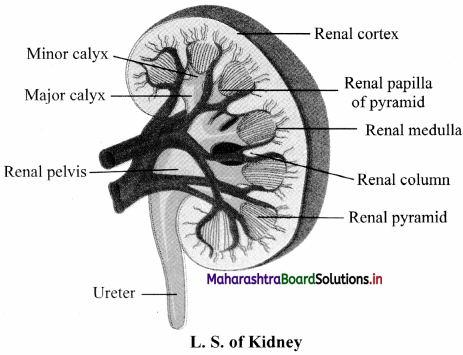
Question 20.
What is nephrology?
Answer:
Nephrology is branch of biology that deals with the structure, function and disorders of male and female urinary system.
![]()
Question 21.
Write a note on nephron.
Answer:
- Nephrons are structural and functional units of kidney.
- Each nephron consists of a 4 – 6 cm long, thin-walled tube called the renal tubule and a bunch of capillaries known as the glomerulus.
- The wall of the renal tubule is made up of a single layer of epithelial cells.
- Its proximal end is wide, blind, cup-like and is called as Bowman’s capsule, whereas the distal end is open.
- The nephron is divisible into Bowman’s capsule, neck, proximal convoluted tubule (PCT), Loop of Henle (LoH), distal convoluted tubule (DCT) and collecting tubule (CT).
- The glomerulus is present in the cup-like cavity of Bowman’s capsule and both are collectively known as renal corpuscle or Malpighian body.
Question 22.
With the help of a well labelled diagram, describe the structure of nephron.
Answer:
Nephron is the structural and functional unit of kidney.
Structure of nephron:
A nephron (uriniferous tubule) is a thin walled, coiled duct, lined by a single layer of epithelial cells. Each nephron is divided into two main parts:
i. Malpighian body
ii. Renal tubule
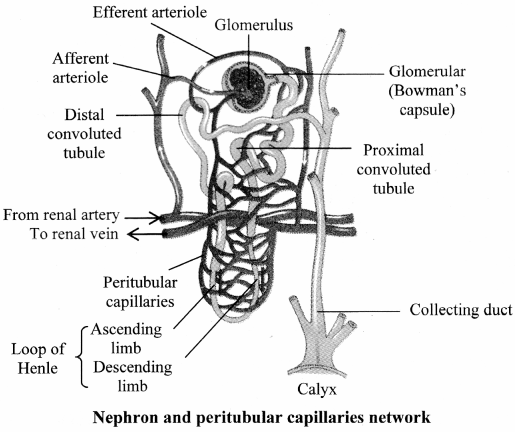
i. Malpighian body: Each Malpighian body is about 200pm in diameter and consists of a Bowman’s capsule and glomerulus.
a. Glomerulus:
Glomerulus is a bunch of fine blood capillaries located in the cavity of Bowman’s capsule.
A small terminal branch of the renal artery, called as afferent arteriole enters the cup cavity (Bowman capsule) and undergoes extensive fine branching to form network of several capillaries. This bunch is called as glomerulus.
The capillary wall is fenestrated (perforated).
All capillaries reunite and form an efferent arteriole that leaves the cup cavity.
The diameter of the afferent arteriole is greater than the efferent arteriole. This creates a high hydrostatic pressure essential for ultrafiltration, in the glomerulus.
b. Bowman’s capsule:
It is a cup-like structure having double walls composed of squamous epithelium.
The outer wall is called as parietal wall and the inner wall is called as visceral wall.
The parietal wall is thin consisting of simple squamous epithelium.
There is a space called as capsular space / urinary space in between two walls.
Visceral wall consists of special type of squamous cells called podocytes having a foot-like pedicel. These podocytes are in close contact with the walls of capillaries of glomerulus.
There are small slits called as filtration slits in between adjacent podocytes.
ii. Renal tubule:
a. Neck:
The Bowman’s capsule continues into the neck. The wall of neck is made up of ciliated epithelium. The lumen of the neck is called the urinary pole. The neck leads to proximal convoluted tubule.
b. Proximal Convoluted Tubule :
This is highly coiled part of nephron which is lined by cuboidal cells with brush border (microvilli) and surrounded by peritubular capillaries. Selective reabsorption occurs in PCT. Due to convolutions (coiling), filtrate flows slowly and remains in the PCT for longer duration, ensuring that maximum amount of useful molecules are reabsorbed.
c. Loop of Henle :
This is ‘U’ shaped tube consisting of descending and ascending limb.
The descending limb is thin walled and permeable to water and lined with simple squamous epithelium.
The ascending limb is thick walled and impermeable to water and is lined with simple cuboidal epithelium.
The LoH is surrounded by capillaries called vasa recta.
Its function is to operate counter current system – a mechanism for osmoregulation.
The ascending limb of Henle’s loop leads to DCT.
d. Distal convoluted tubule:
This is another coiled part of the nephron.
Its wall consists of simple cuboidal epithelium.
DCT performs tubular secretion / augmentation / active secretion in which, wastes are taken up from surrounding capillaries and secreted into passing urine.
DCT helps in water reabsorption and regulation of pH of body fluids.
e. Collecting tubule:
This is a short, straight part of the DCT which reabsorbs water and secretes protons.
The collecting tubule opens into the collecting duct.
Question 23.
What is the difference between Cortical nephrons and Juxtamedullary nephrons.
Answer:
|
|
Cortical nephrons |
Juxtamedullary nephrons |
| i. | They have a shorter loop of Henle. | They have a longer loop of Henle. |
| ii. | Loop of Henle of these nephrons extends very little into the medulla. | Loop of Henle of these nephrons run deep into the medulla. |
| iii. | Most nephrons are cortical nephrons. | Few nephrons are juxtamedullary nephrons. |
| iv. | Efferent arteriole forms peritubular capillary network around DCT, PCT and Henle’s loop of cortical nephrons | Efferent arteriole forms loop-shaped vasa recta around Henle’s loop of juxtamedullary nephrons. |
Question 24.
Sketch and label Malpighian body.
Answer:

Question 25.
What are podocytes? In which part of the nephron are they present?
Answer:
Podocytes are a special type of squamous cells that have a foot-like pedicel. They are present in the visceral wall of the Bowman’s capsule and are in close contact with the walls of capillaries of glomerulus
![]()
Question 26.
Write a short note on Juxta Glomerular Apparatus.
Answer:
- Some smooth muscle cells of the wall of afferent arteriole are modified in such a way that their sarcoplasm is granular. These cells are called juxtaglomerular (JG) cells.
- In each nephron, initial part of DCT makes contact with the afferent arteriole of same nephron.
- Cells in the wall of DCT in this region are packed more densely than those in other region of DCT. This is called macula densa.
- Macula densa and the JG cells together form Juxta Glomerular Apparatus (JGA).
- The JGA plays an important role in blood pressure regulation within the kidney.
Question 27.
Explain the mechanism of urine formation in detail.
Answer:
Process of urine formation is completed in three steps, namely;
i. Ultrafiltration/ Glomerular filtration,
ii. Selective reabsorption,
iii. Tubular secretion / Augmentation
i. Ultrafiltration / Glomerular filtration :
Diameter of afferent arteriole is greater than the efferent arteriole. The diameter of capillaries is still smaller than both arterioles. Due to the difference in diameter, blood flows with greater pressure through the glomerulus. This is called as glomerular hydrostatic pressure (GHP) and normally, it is about 55 mmHg. GIIP is opposed by osmotic pressure of blood (normally, about 30 mm Hg) and capsular pressure (normally, about 15 mm Hg).
Hence net / effective filtration pressure (EFP) is 10 mm Hg.
EFP = Hydrostatic pressure in glomerulus – (Osmotic pressure of blood + Filtrate Hydrostatic pressure)
= 55 – (30 +15)
= 10 mm Hg
Under the effect of high pressure, the thin walls of the capillary become permeable to major components of blood (except blood cells and macromolecules like protein).
Thus, plasma except proteins oozes out through wall of capillaries.
About 600 ml blood passes through each kidney per minute.
The blood (plasma) flowing through kidney (glomeruli) is filtered as glomerular filtrate, at a rate of 125 ml / min. (180 L/d).
Glomerular filtrate / deproteinized plasma / primary urine is alkaline, contains urea, amino acids, glucose, pigments, and inorganic ions.
Glomerular filtrate passes through filtration slits into capsular space and then reaches the proximal convoluted tubule.
ii. Selective reabsorption :
Selective reabsorption occurs in proximal convoluted tubule (PCT). It is highly coiled so that glomerular filtrate passes through it very slowly. Columnar cells of PCT are provided with microvilli due to which absorptive area increases enormously.
This makes the process of reabsorption very effective.
These cells perform active (ATP mediated) and passive (simple diffusion) reabsorption.
Substances with considerable importance (high threshold) like – glucose, amino acids, vitamin C, Ca++, K+, Na+, Cl– are absorbed actively, against the concentration gradient. Low threshold substances like water, sulphates, nitrates, etc., are absorbed passively.
In this way, about 99% of glomerular filtrate is reabsorbed in PCT and DCT.
iii. Tubular secretion / Augmentation :
Finally filtrate reaches the distal convoluted tubule via loop of Henle. Peritubular capillaries surround DCT. Cells of distal convoluted tubule and collecting tubule actively absorb the wastes like creatinine and ions like K+, H+ from peritubular capillaries and secrete them into the lumen of DCT and CT, thereby augmenting the concentration of urine and changing its pH from alkaline to acidic.
Secretion of H+ ions in DCT and CT is an important homeostatic mechanism for pH regulation of blood. Tubular secretion is the only process of excretion in marine bony fishes and desert amphibians.
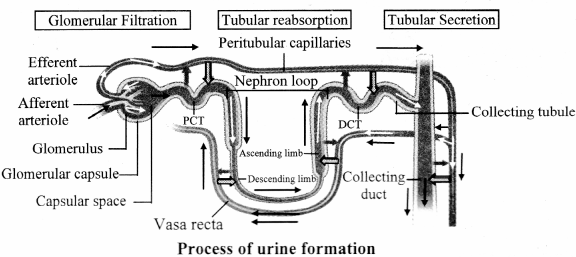
Question 28.
Marine bony fishes and desert amphibians rely on which process of excretion?
Answer:
Tubular secretion
Question 29.
Where does selective reabsorption of glomerular filtrate take place?
Answer:
Selective reabsorption of glomerular filtrate takes place in the proximal convoluted tubule (PCT).
Question 30.
What is glomerular filtration pressure or net effective filtration pressure?
Answer:
Glomerular filtration pressure (GFP)/ Effective filtration pressure (EFP) is the difference between the hydrostatic pressure (GHP) and the sum of osmotic pressure of blood and capsular pressure (CHP).
It can be represented as:
EFP = Glomerular hydrostatic pressure – (Osmotic pressure of blood + Filtrate Flydrostatic pressure)
= 55 – (30 + 15)
= 10 mmHg
[Note: Net filtration pressure = Glomerular blood hydrostatic pressure – (Capsular hydrostatic pressure + Blood colloid osmotic pressure)
Source: Tort or a, G., Derrickson, B. Principles of Anatomy and Physiology. 11th Edition.]
Question 31.
Distinguish between Selective reabsorption and Tubular secretion.
Answer:
|
No. |
Selective rcabsorption |
Tubular secretion |
| i. | Selective reabsorption is concerned with the selective absorption of useful substances from the glomerular filtrate. | Tubular secretion is transfer of materials from peritubular capillaries to the renal tubular lumen. |
| ii. | Substances with considerable importance (high threshold) like – glucose, amino acids, vitamin C, Ca++, K+, Na+, Cl– are absorbed actively, against concentration gradient | In this process, substances like urea. amino acids, glucose, pigments, and inorganic ions arc removed from the blood and discharged along with the urine. |
| iii. | Selective reabsorption occurs in Proximal convoluted tubule, Henle’s loop, Distal convoluted tubule and collecting duct. | Tubular secretion occurs in Distal convoluted tubules only. |
![]()
Question 32.
Explain the process of concentration of urine in deai1.
OR
Explain counter current mechanism in detail.
Answer:
Under the conditions like low water intake or high water loss due to sweating, humans can produce concentrated urine. This urine can be concentrated around four times i.e. 1200 mOsm/L, than the blood (300 mOsm/L). hence, a mechanism called countercurrent mechanism is operated in the human kidneys. The countercurrent mechanism operating in the Limbs of Henle’s loop of juxtamedullarv nephrons and vasa recta is as follows:
i. It involves the passage of fluid from descending to ascending limb of Henle’s loop.
ii. This mechanism is called countercurrent mechanism, since the flow of tubular fluid is in opposite direction through both limbs.
iii. In case of the vasa recta, blood flows from ascending to descending parts of itself.
iv. Wall of descending limb is thin and permeable to water, hence, water diffuses from tubular fluid into tissue fluid due to which, tubular fluid becomes concentrated.
v. The ascending limb is thick and impermeable to water. Its cells can reabsorb Na+ and Cl– from tubular fluid and release into tissue fluid.
vi. Due to this, tissue fluid around descending limb becomes concentrated. This makes more water to move out from descending limb into tissue fluid by osmosis.
vii. Thus, as tubular fluid passes down through descending limb, its osmolarity (concentration) increases gradually due to water loss and on the other hand, progressively decreases due to Na+ and Cl– secretion as it flows up through ascending limb.
viii. Whenever retention of water is necessary, the pituitary secretes ADH. ADH makes the cells in the wall of collecting ducts permeable to water.
ix. Due to this, water moves from tubular fluid into tissue fluid, making the urine concentrated.
x. Cells in the wall of deep medullar part of collecting ducts are permeable to urea. As concentrated urine flows through it, urea diffuses from urine into tissue fluid and from tissue fluid into the tubular fluid flowing through thin ascending limb of Henle’s loop.
xi. This urea cannot pass out from tubular fluid while flowing through thick segment of ascending limb, DCT and cortical portion of collecting duct due to impermeability for it in these regions.
xii. However, while flowing through collecting duct, water reabsorption is operated under the influence of ADII. Due to this, urea concentration increases in the tubular fluid and same urea again diffuses into tissue fluid in deep medullar region.
xiii. Thus, same urea is transferred between segments of renal tubule and tissue fluid of inner medulla. This is called urea recycling; operated for more and more water reabsorption from tubular fluid and thereby excreting small volumes of concentrated urine.
xiv. Osmotic gradient is essential in the renal medulla for water reabsorption by counter current multiplier system.
xv. This osmotic gradient is maintained by vasa recta by operating counter current exchange system.
xvi. Vasa recta also have descending and ascending limbs. Blood that enters the descending limb of the vasa recta has normal osmolarity of about 300 mOsm/L.
xvii. As it flows down in the region of renal medulla where tissue fluid becomes increasingly concentrated, Na+, Cl– and urea molecules diffuse from tissue fluid into blood and water diffuse from blood into tissue fluid.
xviii. Due to this, blood becomes more concentrated which now flows through ascending part of vasa recta. This part runs through such region of medulla where tissue fluid is less concentrated.
xix. Due to this, Na+, Cl– and urea molecules diffuse from blood to tissue fluid and water from tissue fluid to blood. This mechanism helps to maintain the osmotic gradient.
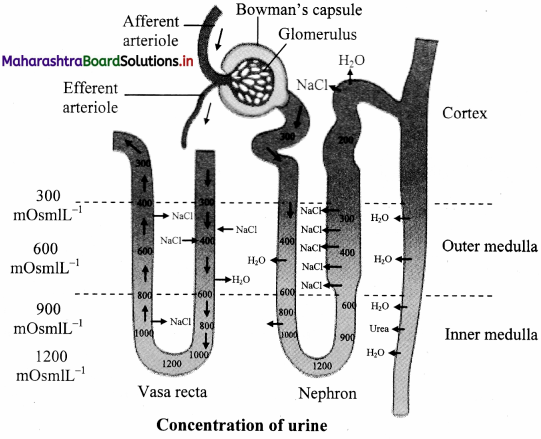
Question 33.
Camel excretes concentrated urine. Give reason.
Answer:
In order to reabsorb water to maximum capacity, loop of Henle is longer in desert mammals like camel. Hence, camel excretes concentrated urine.
Question 34.
Why is urine yellow in colour?
Answer:
Normal urine is pale yellow coloured transparent liquid, due to the pigment urochrome.
Question 35.
How is the composition of urine regulated?
Answer:
The composition of urine depends upon food and fluid consumed by an individual. There are two ways in which it the composition is regulated. They are as follows:
- Regulating water reabsorption through ADH
- Electrolyte reabsorption though RAAS
- Atrial Natriuretic Peptide
i) Regulating water reabsorption through ADH:
Hypothalamus in the midbrain has special receptors called osmoreceptors which can detect change in osmolarity (measure of total number of dissolved particles per liter of solution) of blood.
If osmolarity of blood increases due to water loss from the body (after eating namkeen or due to sweating), osmoreceptors trigger release of Antidiuretic hormone (ADH) from neurohypophysis (posterior pituitary). ADH stimulates reabsorption of water from last part of DCT and entire collecting duct by increasing the permeability of cells.
This leads to reduction in urine volume and decrease in osmolarity of blood.
Once the osmolarity of blood comes to normal, activity of osmoreceptor cells decreases leading to decrease in ADH secretion. This is called negative feedback.
In case of hemorrhage or severe dehydration too, osmoreceptors stimulate ADH secretion. ADH is important in regulating water balance through kidneys.
In absence of ADH, diuresis (dilution of urine) takes place and person tends to excrete large amount of dilute urine. This condition called as diabetes insipidus.
[Note: Hypothalamus is a part of forebrain]
ii) Electrolyte reabsorption through RAAS:
Another regulatory mechanism is RAAS (Renin Angiotensin Aldosterone System) by Juxta Glomerular Apparatus (JGA).
Whenever blood supply (due to change in blood pressure or blood volume) to afferent arteriole decreases (e.g. low BP/dehydration), JGA cells release Renin. Renin converts angiotensinogen secreted by hepatocytes in liver to Angiotensin I. ‘Angiotensin converting enzyme’ further modifies Angiotensin I to Angiotensin II, the active form of hormone. It stimulates adrenal cortex to release another hormone called aldosterone that stimulates DCT and collecting ducts to reabsorb more Na and water, thereby increasing blood volume and pressure.
iii) Atrial natriuretic peptide (ANP):
A large increase in blood volume and pressure stimulates atrial wall to produce atrial natriuretic peptide (ANP). ANP inhibits Na+ and Cl reabsorption from collecting ducts inhibits release of renin, reduces aldosterone and ADH release too. This leads to a condition called Natriuresis (increased excretion of Na+ in urine) and diuresis.
![]()
Question 36.
What is renin? Give its function.
Answer:
Renin is an enzyme secreted by juxtaglomerular cells of afferent arteriole.
Function: It activates Angiotensinogen to Angiotensin-I.
Question 37.
What is the function of Angiotensin II?
Answer:
Functions of Angiotensin II:
- It constricts arterioles in kidney thereby reducing blood flow and increasing blood pressure.
- It stimulates PCT cells to enhance reabsorption of Na+, Cl– and water.
- It stimulates adrenal cortex to release another hormone called aldosterone that stimulates DCT and collecting ducts to reabsorb more Na and water, thereby increasing blood volume and pressure.
Question 38.
Which hormones and factors are involved in regulation of kidney function?
Answer:
Hormones like ADH, Renin, Angiotensin and Atrial Natriuretic Peptide (ANP) are involved in regulation of kidney function.
Question 39.
Can improper kidney function lead to brittle bones? Justify your answer.
Answer:
Yes, improper kidney function lead to brittle bones.
- Kidneys participate in synthesis of calcitriol, the active form of Vitamin D which is needed for absorption of dietary calcium.
- Deficiency of calcitriol can lead to brittle bones.
Question 40.
Do organs other than kidney participate in excretion? Explain.
Answer:
Yes, various organs other than the kidney participate in excretion. They are as follows:
i. Skin:
Skin acts as an accessory excretory organ. The skin of many organisms is thin and permeable. It helps in diffusion of waste products like ammonia.
Human skin however is thick and impermeable. It shows presence of two types of glands namely, sweat glands and sebaceous glands.
a. Sweat glands are distributed all over the skin. They are abundant in the palm and facial regions. These simple, unbranched, coiled, tubular glands open on the surface of the skin through an opening called sweat pore. Sweat is primarily produced for thermoregulation but it also excretes substances like water, NaCl, lactic acid and urea.
b. Sebaceous glands are present at the neck of hair follicles. They secrete oily substance called sebum. It forms a lubricating layer on skin making it softer. It protects skin from infection and injury.
ii. Lungs:
Lungs are the accessory excretory organs. They help in excretion of volatile substances like C02 and water vapour produced during cellular respiration. Along with CO2, lungs also remove excess of H2O in the form of vapours during expiration. They also excrete volatile substances present in spices and other food stuff.
Question 41.
Enlist the human excretory organs and their excretory products.
Answer:
Excretory OrgAnswer:
- Lungs: Remove CO2 and also water vapour to a considerable extent. Volatile substances present in spices and other food stuff are excreted through lungs
- Kidneys: Remove nitrogenous waste products like ammonia, urea and uric acid, creatinine. They also remove excessive amount of water, salts and certain minerals.
- Skin: Remove water, NaCl, lactic acid and urea by through of sweat.
Question 42.
What is albuminaria? What are its causes?
Answer:
- Albuminaria is the presence of excess albumin in the urine.
- Causes: Injury to the endothelial capsular membrane as a result of increased blood pressure, injury or irritation of kidney cells by substances such as toxins or heavy metals.
![]()
Question 43.
A patient report indicates presence of excessive quantities of ketone bodies in the urine. What does this indicate? How is it caused?
Answer:
Presence of excessive quantities of ketone bodies in the urine indicates that the patient is suffering from diabetes mellitus, starvation or too little carbohydrates in the diet.
Question 44.
Sheela is suffering from kidney infection. Presence of which type of cells in the urine can be indicative of this?
Answer:
Presence of leucocytes in the urine can be indicative of infection of kidney or other urinary organs.
Question 45.
Enlist the various disorders and diseases related to the excretory system.
Answer:
Some disorders and diseases related to the excretory system are as follows:
- Kidney stones
- Uremia
- Nephritis
- Renal Failure
- Ketonuria
- Albuminaria
Question 46.
Write a note on kidney stones with reference to types, symptoms and diagnosis.
Answer:
Kidney stones are also called renal calculi. They may be formed in any portion of urinary tract, from kidney tubules to external opening.
Types:
Depending on their composition, kidney stones are classified into the following types.
- Calcium stones : These are usually calcium oxalate or calcium phosphate stones.
- Struvite stones : These are formed in response to bacterial infection caused by urea – splitting bacteria. They grow in size quickly and become quite large.
- Uric acid stones : These stones usually affect people drinking less water or consuming high protein diet.
- Cystine stones : It is a genetic disorder that causes the kidney to excrete too much of certain amino acid.
Symptoms:
Intermittent pain below rib cage in back and side ways. Hazy, brownish/reddish/ pinkish urine. Frequent urge to pass urine. Pain during micturition.
Diagnosis:
Uric acid content of blood, colour of urine, kidney X-ray, sonography of kidney are different diagnostic tests prescribed depending on symptoms.
Question 47.
What is uremia?
Answer:
If the level of urea in blood rises above 0.05%, the condition is known as uremia. It may lead to kidney failure.
Question 48.
What is the normal content of urea in blood?
Answer:
The normal content of urea in blood is 0.01 to 0.03 %.
Question 49.
Write a note on nephritis.
Answer:
- Nephritis is the inflammation of kidneys characterised by proteinuria.
- It is caused due to increased permeability of glomerular capsular membrane, permitting large amounts of proteins to escape from blood to urine.
- This leads to change in blood colloidal osmotic pressure, leading to movement of fluid from blood to interstitial spaces.
- It is reflected as edema.
![]()
Question 50.
What is renal failure? Describe its types.
Answer:
Renal failure is the decrease or cessation of glomerular filtration and ¡s classified into two types.
i) Acute Renal failure (ARF):
ARF is sudden worsening of renal function that most commonly happens after severe bleeding. There is a decrease in urine output (oligouriaf scanty urine i.e., less than 400 mi/day or less than 0.5 ml/kg/li in children). Other causes of ARF may include acute obstruction of both ureters or nephrotoxic drugs. ARF can be detected biochemically by elevated serum creatinine levels.
ii) Chronic kidney disease (CKD) :
It is the progressive and generally irreversible decline in glomerular filtration rate (GFR). It may be caused due to chronic glomerulonephritis. It can be detected by reduced kidney size and possibility of anaemia.
Question 51.
When does a patient need to undergo haemodialysis? Explain the process in detail.
Answer:
- When renal function of a person falls below 5 – 7 %, accumulation of harmful substances in blood begins. In such a condition, the person has to go for artificial means of filtration of blood i.e. haemodialysis.
- In haemodialysis, a dialysis machine is used to filter blood. The blood is filtered outside the body using a dialysis unit.
- In this procedure, the patients’ blood is removed; generally from the radial artery and passed through a cellophane tube that acts as a semipermeable membrane.
- The tube is immersed in a fluid called dialysate which is isosmotic to normal blood plasma. Hence, only excess salts if present in plasma pass through the cellophane tube into the dialysate.
- Waste substances being absent in the dialysate, move from blood into the dialyzing fluid.
- Filtered blood is returned to vein.
- In this process it is essential that anticoagulant like heparin is added to the blood while it passing through the tube and before resending it into the circulation, adequate amount of anti-heparin is mixed.
- Also, the blood has to move slowly through the tube and hence the process is slow.
Question 52.
Write a note on peritoneal dialysis.
Answer:
- In this method, the dialyzing fluid is introduced in abdominal cavity or peritoneal cavity.
- The peritoneal membrane acts as semipermeable dialyzing membrane.
- Toxic wastes and extra solutes pass into the fluid.
- This fluid is drained out after a prescribed period of time.
- Peritoneal dialysis can be repeated as per the need of the patient.
- It can be carried out at home at work or while travelling. But it is not as efficient as haemodialysis.
Question 53.
What are the drawbacks of haemodialysis?
Answer:
- Kidneys are associated with secretion of erythropoietin, renin and calcitriol which is not possible using dialysis machine.
- During dialysis, the blood has to move slowly through the tube and hence the process is slow.
Question 54.
What is kidney transplant?
Answer:
- It is the organ transplant of a healthy kidney into a patient with end – stage renal disease.
- Kidney transplantation is classified as cadaveric (deceased donor) or living donor kidney transplant.
- Living donor kidney transplant are further classified as genetically related (living-related) or non-related (living non-related) transplants.
![]()
Question 55.
Complete the diagram / chart with correct labels / information. Write the conceptual details regarding it.
i)

Answer:
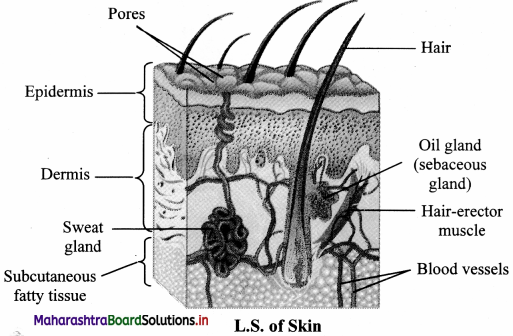
Skin:
Skin acts as an accessory excretory organ. The skin of many organisms is thin and permeable. It helps in diffusion of waste products like ammonia.
Human skin however is thick and impermeable. It shows presence of two types of glands namely, sweat glands and sebaceous glands.
a. Sweat glands are distributed all over the skin.
They are abundant in the palm and facial regions. These simple, unbranched, coiled, tubular glands open on the surface of the skin through an opening called sweat pore. Sweat is primarily produced for thermoregulation but it also excretes substances like water, NaCI, lactic acid and urea.
b. Sebaceous glands are present at the neck of hair follicles.
They secrete oily substance called sebum. It forms a Lubricating layer on skin making it softer. It protects skin from infection and injury.
ii)
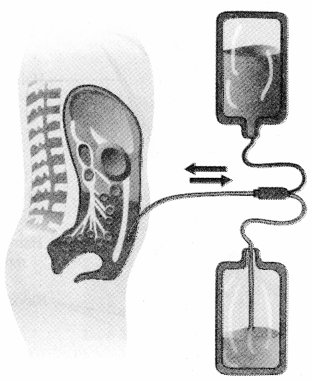
Answer:
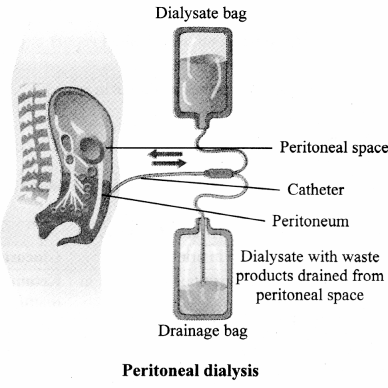
- In this method, the dialyzing fluid is introduced in abdominal cavity or peritoneal cavity.
- The peritoneal membrane acts as semipermeable dialyzing membrane.
- Toxic wastes and extra solutes pass into the fluid.
- This tluid is drained out after a prescribed period of time.
- Peritoneal dialysis can be repeated as per the need of the patient.
- It can be carried out at home at work or while travelling. But it is not as efficient as haemodialysis.
Question 55.
Invertebrates, bony fishes, tadpoles, etc. are ammonotelic. Whereas birds, reptiles, land snails, etc. are uricotelic. What would be the probable reason for the difference in mode of excretion?
i. Ammonotelic organisms conserve water as conversion of ammonia to uric acid requires large amount of water.
ii. Elimination of ammonia requires large quantity of water, thus ammonotelism is seen in aquatic animals.
iii. Uricotelic organisms require moderate water for eliminating urea and formation of ammonia requires expenditure of energy. Thus, to conserve water and energy, these animals have uricotelism mode of excretion.
iv. Aquatic animals can retain ammonia and store it in the body for long time.
(A) i and iii
(B) only ii
(C) only iv
(D) ii and iii
Answer:
(B)
Question 56.
A lab technician was evaluating blood reports of some patients. She observed the following values of the report:
| Sr. No. | Patient | Comments on urine/ blood report |
| i. | A | High levels of glucose in urine |
| ii. | B | Presence of excess quantities of ketone in urine |
| iii. | C | Presence of leucocytes in urine |
| iv. | D | 0.06% urea in blood |
| V. | E | High level of proteins in blood |
Read the given comments and discuss what disorder/disease the patient must be suffering from.
Answer:
| Sr. No. | Patient | Comments on urine/ blood report | Disorder/ Disease |
| i. | A | High levels of glucose in urine | Glucosuria |
| ii. | B | Presence of excess quantities of ketone in urine | Ketonuria (Indicative of diabetes mellitus) |
| iii. | C | Presence of leucocytes in urine | Infection of kidney or urinary organs |
| iv. | D | 0.06% urea in blood | Uremia |
| V. | E | High level of proteins in blood | Proteinuria/ Nephritis |
Multiple Choice Questions
Question 1.
Uric acid is the main nitrogenous waste in
(A) birds
(B) cartilaginous fish
(C) mammals
(D) larval amphibians
Answer:
(A) birds
Question 2.
Protonephridia is the excretory organ of
(A) platyhelminthes
(B) coelenterates
(C) arthropods
(D) aschelminthes
Answer:
(A) platyhelminthes
![]()
Question 3.
The glomerulus receives blood through the
(A) vasa recta
(B) renal artery
(C) afferent arteriole
(D) efferent arteriole
Answer:
(C) afferent arteriole
Question 4.
More ADH results in
(A) reduced permeability of DCT
(B) dilute urine
(C) reduced blood pressure
(D) concentrated urine
Answer:
(D) concentrated urine
Competitive Corner
Question 1.
Match the items in Column-I with those in Column-II [NEET Odisha 2019]
|
|
Column-I | Column-II | |
| i. | Podocytes | a. | Crystallised oxalates |
| ii. | Protonephridia | b. | Annelids |
| iii. | Nephridia | c. | Amphioxus |
| iv. | Renal calculi | d. | Filtration slits |
Select the correct option from the following:
(A) i-d, ii-b, iii-c, iv-a
(B) i-c, ii-d, iiii-b, iv-a
(C) i-c, ii-b, iii-d, iv-a
(D) i-d, ii-c, iii-b, iv-a
Answer:
(D) i-d, ii-c, iii-b, iv-a
Question 2.
Match the following parts of a nephron with their function: [NEET Odisha 2019]
| i. | Descending limb of Henle’s loop | a. | Reabsorption of salts only |
| ii. | Proximal convoluted tubule | b. | Reabsorption of water only |
| iii. | Ascending limb of Henle’s loop | c. | Conditional reabsorption of sodium ions and water |
| iv. | Distal convoluted tubule | d. | Reabsorption of ions, water and organic nutrients |
Select the correct option from the following:
(A) i-d, ii-a, iii-c, iv-b
(B) i-a, ii-c, iii-b, iv-d
(C) i-b, ii-d, iii-a, iv-c
(D) i-a, ii-d, iii-b, iv-c
Answer:
(C) i-b, ii-d, iii-a, iv-c
Question 3.
Which of the following factors is responsible for the formation of concentrated urine? [NEET(UG) 2019]
(A) Secretion of erythropoietin by Juxtaglomerular complex.
(B) Hydrostatic pressure during glomerular filtration.
(C) Low levels of antidiuretic hormone.
(D) Maintaining hyperosmolarity towards inner medullary interstitium in the kidneys.
Answer:
(D) Maintaining hyperosmolarity towards inner medullary interstitium in the kidneys.
![]()
Question 4.
Portions of renal cortex, which are projected into renal medulla, among the renal pyramids are called as _______. [MHT CET 2019]
(A) Columns of Bertini
(B) Columnae Camae
(C) Ampullae
(D) Ducts of Bellini
Answer:
(A) Columns of Bertini
Question 5.
Renal failure is typically detected by biochemical analysis of blood which shows _______. [MHT CET 2019]
(A) increased level of amino acids
(B) lower level of uric acid
(C) lower level of serum creatinine
(D) higher level of serum creatinine
Answer:
(D) higher level of serum creatinine
Question 6.
Which of the following statements is CORRECT with reference to nephron? [MHT CET 2019]
(A) ADH hormone increases permeability of PCT cells to reabsorb water.
(B) Efferent arteriole forms peritubular network all around tubule.
(C) Podocytes occur in ascending limb of loop of Henle.
(D) Descending limb of Henle’s loop is impenneable to water.
Answer:
(B) Efferent arteriole forms peritubular network all around tubule.
Question 7.
Match the items given in Column I with those in Column li and select the correct option given below. [NFET (UG) 2018]
|
|
Column I (Function) |
Column II (Part of excretory system) |
|
| i. | Ultrafiltration | a. | Henle’s loop |
| ii. | Concentration of urine | b. | Ureter |
| iii. | Transport of urine | c. | Urinary bladder |
| iv. | Storage of urine | d. | Malpighian corpuscle |
| v. | e. | Proximal convoluted tubule |
(A) i-e, ii-d, iii-a, iv-b
(B) i-d, ii-a, iii-b, iv-c
(C) i-d, ii-e, iii-b, iv-c
(D) i-e, ii-d, iii-a, iv-c
Answer:
(B) i-d, ii-a, iii-b, iv-c
Question 8.
Match the items given in Column I with those in Column II and select the correct option given below. [NEET (UG) 2018]
|
|
Column I |
Column II |
|
| i. | Glycosuria | a. | Accumulation of uric acid in joints |
| ii. | Gout | b. | Mass of crystalised salts within the kidney |
| iii. | Renal calculi | c. | Inflammation of glomeruli |
| iv. | Glomerular nephritis | d. | Presence of glucose in urine |
(A) i-b, ii-c, iii-a, iv-d
(B) i-a, ii-b, iii-c, iv-d
(C) i-c, ii-b, iii-d, iv-a
(D) i-d, ii-a, iii-b, iv-c
Answer:
(D) i-d, ii-a, iii-b, iv-c
![]()
Question 9.
In the given diagram of Malpighian body, blood is filtered from part labelled ________
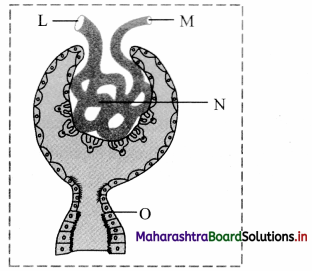
(A) L
(B) M
(C) N
(D) O
Hint: L – Afferent arteriole
M – Efferent arteriole
N – Glomerulus
O – Proximal convoluted tubule
Blood filtration occurs in glomerulus. Afferent arteriole is the blood vessel leading to glomerulus. Efferent arteriole carries blood away from the glomerulus. Proximal convoluted tubule is involved in reabsorption of useful substances from the filtrate.
Answer:
(C) N
Question 10.
Majority of kidney stones consist crystals of [MHT CET 2018]
(A) calcium oxalate, sodium bicarbonate
(B) calcium oxalate, calcium phosphate
(C) calcium phosphate, sodium chloride
(D) calcium carbonate, copper sulphate
Answer:
(B) calcium oxalate, calcium phosphate
Question 11.
Which of the following group of animals is guanotelic? [MHT CEE 2018]
(A) Labeo, turtle, camel
(B) Lizard, snake, scorpion
(C) Penguin, spider, scorpion
(D) Spider, scorpion, snake
Answer:
(C) Penguin, spider, scorpion
Question 12.
Which of the following statements is CORRECT? [NEET (UG) 2017]
(A) The ascending limb of loop of Henle is impermeable to water.
(B) The descending limb of loop of Henle is impermeable to water.
(C) The ascending limb of loop of Henle is permeable to water.
(D) The descending limb of loop of Henle is permeable to electrolytes.
Hint: Descending limb of loop of Henle is permeable to water but impermeable to electrolytes. While ascending limb of loop of Henle is impermeable to water and permeable to electrolytes.
Answer:
(A) The ascending limb of loop of Henle is impermeable to water.
Question 13.
A decrease in blood pressure/volume will not cause the release of [NEET (UG) 2017]
(A) Renin
(B) Atrial Natriuretic Factor
(C) Aldosterone
(D) ADH
Hint: Decrease in blood pressure or volume stimulates the release of renin, aldosterone and ADH. ANF is released when blood pressure increases or blood volume increases. Release of ANF causes vasodilation and also inhibit renin angiotensin mechanism that decreases blood pressure and blood volume.
Answer:
(B) Atrial Natriuretic Factor
![]()
Question 14.
Formation of urea takes place in the _________. [MHT CET 2017]
(A) Heart
(B) Kidney
(C) Liver
(D) Lung
Answer:
(C) Liver
Question 15.
The yellow colour of normal urine is due to [MHT CET 2017]
(A) Bilirubin
(B) Biliverdin
(C) Urochrome
(D) Uric acid
Answer:
Question 16.
Uremia is indicated when the blood urea level rises above _______ [MHT CET 2017]
(A) 0.05%
(B) 0.04%
(C) 0.03%
(D) 0.02 %
Answer:
(A) 0.05%
